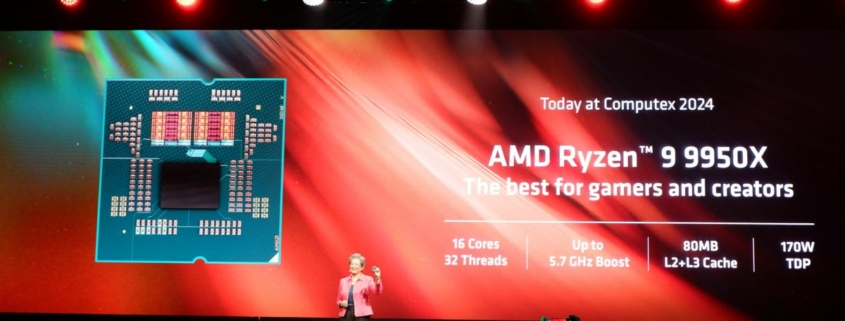Are 16 cores in the new Ryzen 9950X sufficient for gaming? ‘There’s no physical reason we couldn’t do more than 16 cores,’ says AMD

In a Q&A session, after the Zen 5 and Ryzen 9000 series announcements, AMD was grilled on all things AI, data center, and mobile. One question raised pointed out that top-end desktop Ryzen processors have sported a maximum of 16 cores for nearly five years and asked AMD if that was sufficient for the gaming enthusiast PC market. CEO Dr Lisa Su responded that they could add more cores but game developers just aren’t routinely using that many cores in their software.
Specifically, she said that “for gaming, developers have not necessarily used all of the cores from time to time…there’s no physical reason we couldn’t do more than 16 cores…the key is just making sure that we are going at this at a pace that the software guys can utilise it and do utilise it.”
This isn’t surprising, of course, as any PC gaming enthusiast will know that games respond far more to higher clock speeds, more cache, and faster RAM than having more than eight cores and 16 threads. That’s partly because the PlayStation 5 and Xbox Series X/S have eight-core CPUs, one of which is always kept aside for house-keeping duties, so games that are designed to be multi-platform releases are rarely geared toward using more than eight cores for the PC version.
But the main reason is that the processing cycle in the vast majority of games is very linear and much of the sequence doesn’t lend itself particularly well to parallelism. Certain things do, such as pipeline state object caching (aka shader compilation), data decompression, BVH structures building for ray tracing, and object physics, but these aspects are rarely a bottleneck in any game’s overall performance.
One could counter AMD’s argument by pointing out that many of Intel’s gaming CPUs sport far more than 16 cores—the latest Core i9 14900K has 24 cores, the i7 14700K has 20 cores, and even the mid-range Core i5 14600K is packing quite a few, with 14 cores. Intel, though, doesn’t have core parity in its chip designs, unlike in all desktop Ryzens. By that, I mean the 14900K has eight P-cores and 16 E-cores, which aren’t the same as each other.
The latter aren’t clocked as high, don’t support multithreading, and architecturally have performance akin to Core processors from six or so years ago. Threads generated by games are mostly forced to run on the faster, more capable P-cores and the weaker E-cores only get used for threads that are trivial to process.
This is why AMD’s best gaming CPU is the Ryzen 7 7800X3D— just eight cores and 16 threads. Oh, and a small mountain of L3 cache.
Some folks may have been disappointed to see that the newly announced Ryzen 9 9950X is another 16-core chip, because not every PC enthusiast uses their rig for just gaming. I’m one such person and use my main PC for gaming, rendering, and coding. Those last two aspects will happily take as many cores as you like, which I why I’m using a Core i7 14700KF—20 cores and 28 threads, (albeit imbalanced, performance-wise) and considerably cheaper than the Ryzen 9 7950X and the Ryzen 9 7950X3D, both 16 cores, 32 threads.
AMD might be saying that there’s no physical reason why they can’t offer more than 16 cores in its desktop Ryzen chips but there are very good financial reasons as to why. The decision to go down the chiplet route with Zen 3 helped to increase the profitability of AMD’s CPUs because it only has to make two chips—the CCD, comprising the cores and cache, and the IOD, which connects the processor’s CCDs to RAM, SSDs, graphics cards, etc.

Every single Ryzen desktop CPU is made from those same two chiplets, making it cheap and easy to have a broad portfolio of processors, to cover every possible market. If AMD wanted to have a Ryzen with more than 16 cores, then it would need to make a new IOD or use the same one that’s used in Threadrippers and EPYCs.
That’s a larger chiplet and given the overwhelming demand for AMD’s server chips, there probably isn’t enough spare inventory for, say, a 24-core Ryzen.
Computex 2024

Catch up with Computex 2024: We’re on the ground at Taiwan’s biggest tech show to see what Nvidia, AMD, Intel, Asus, Gigabyte, MSI and more have to show.
Given that the Ryzen 9 7950X sells for nearly $500 at the moment (and the new Ryzen 9 9950X is likely to be very pricey when it reaches stores in July), an ultra-niche CPU with more than 16 cores would be far too expensive for most users—even PC enthusiasts.
Factor in the point that it would be no better in gaming than a 7800X3D and have none of the extra features that make Threadrippers so good for the prosumer market, and you’d have a product that wouldn’t sell in sufficient quantities to warrant making it.
Eight cores are going to be fine for gaming for many years still to come and by the time we reach the point where you absolutely need more than this, top-end Ryzen CPUs will be probably sporting way more cores than you’ll ever really need.
Source link




